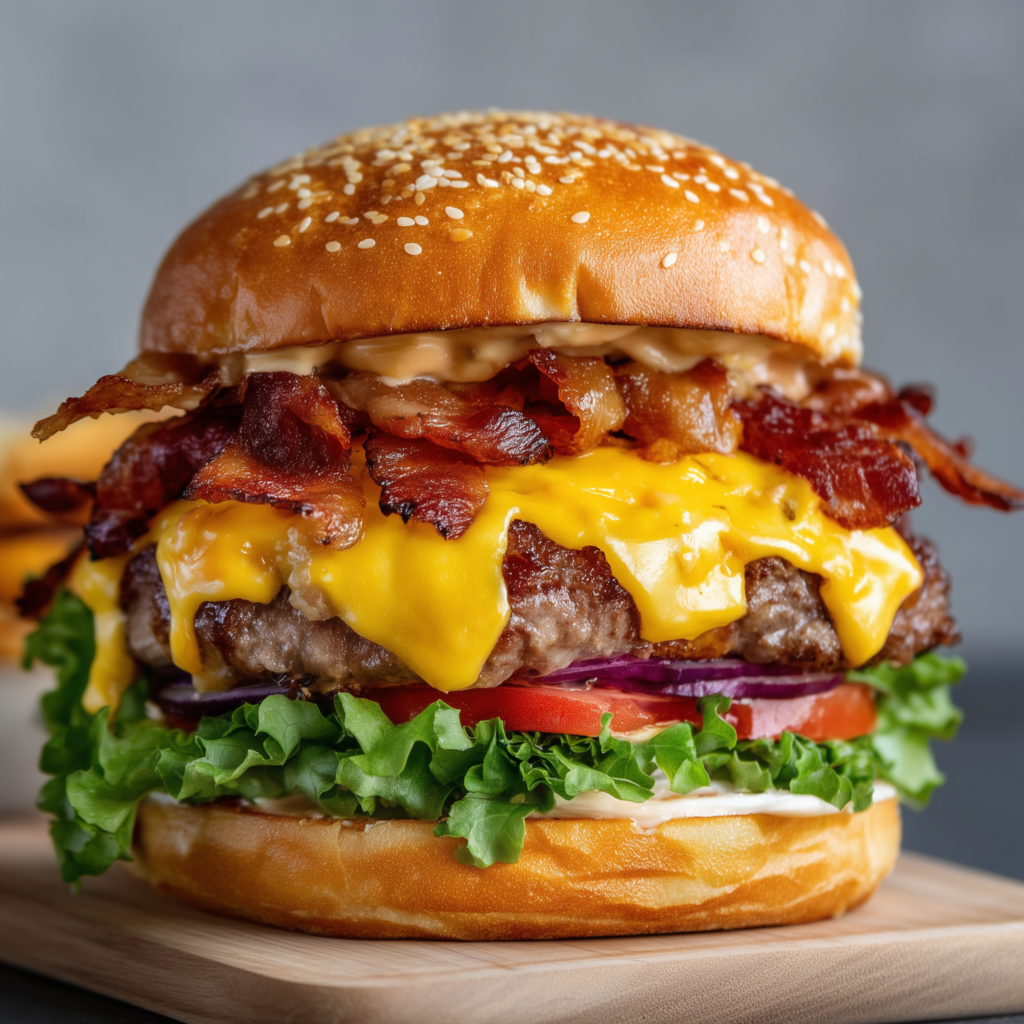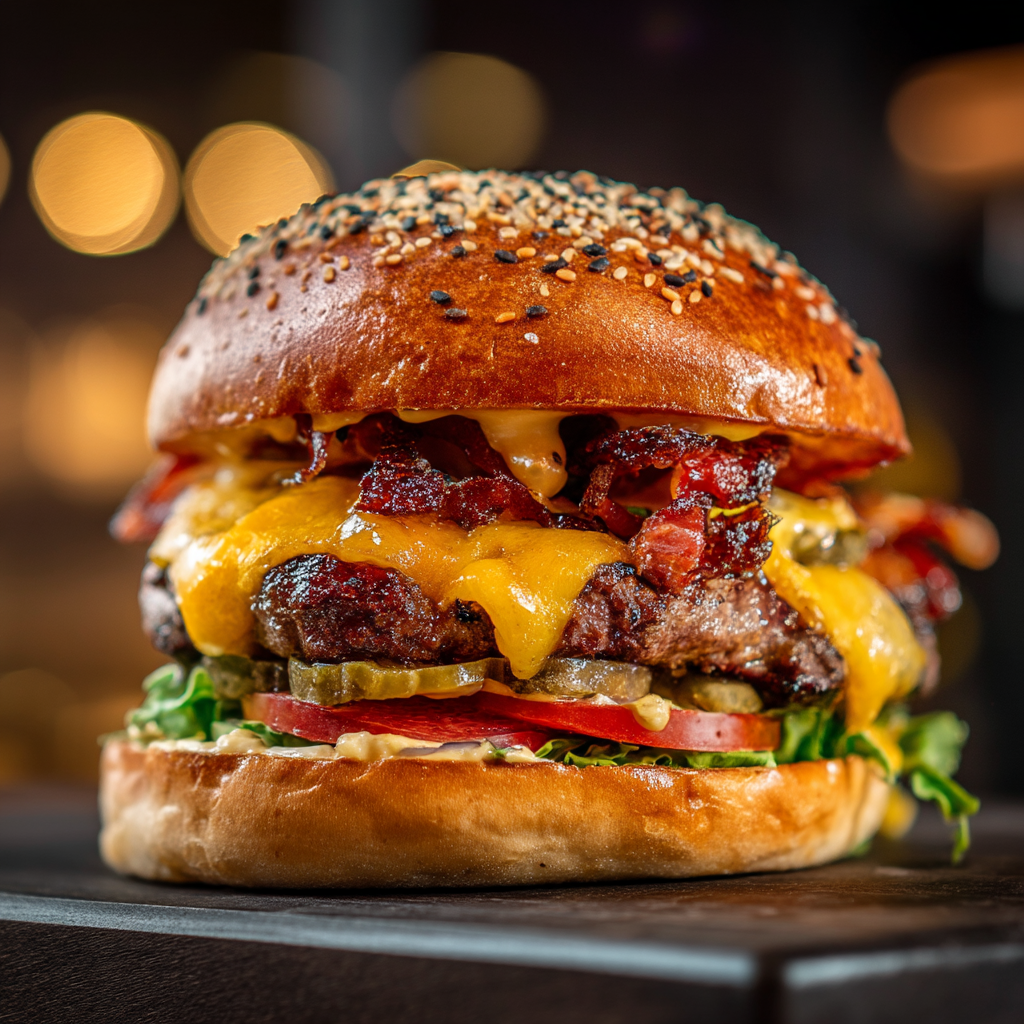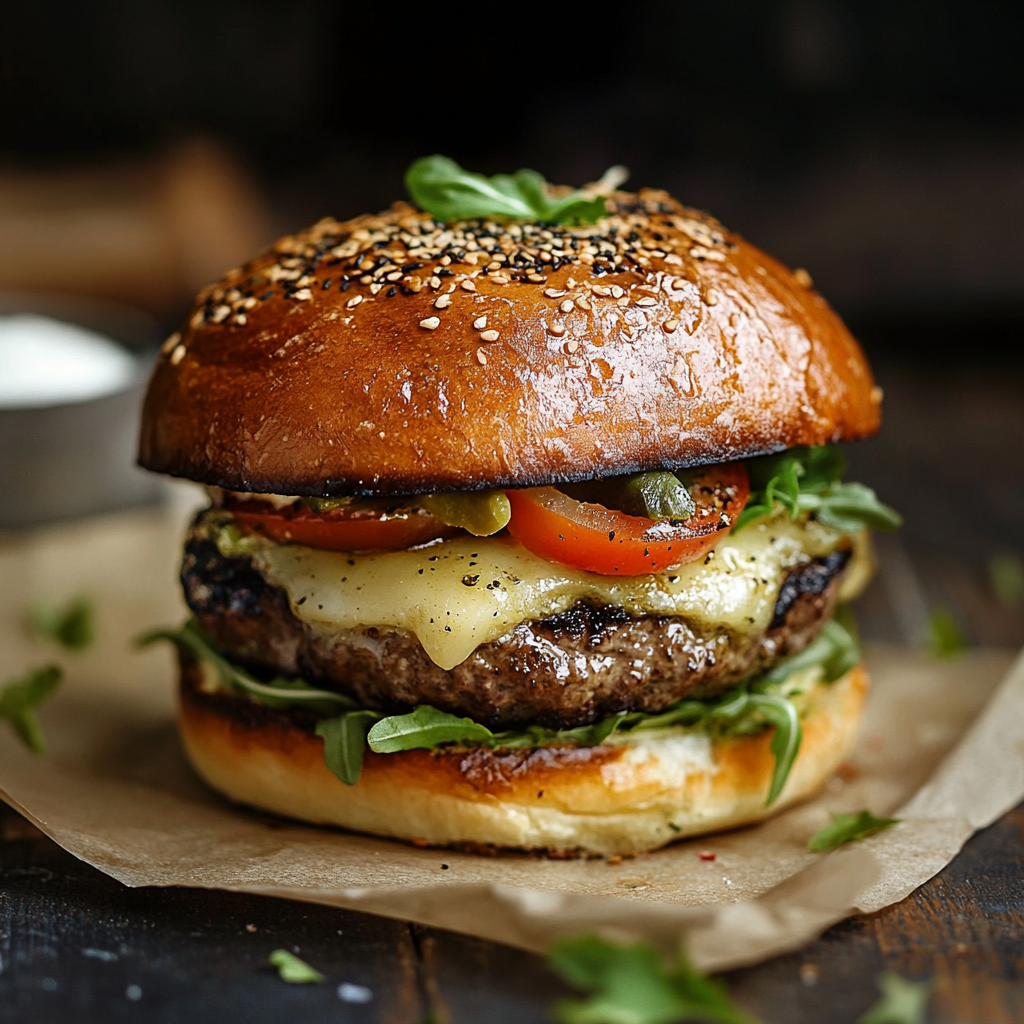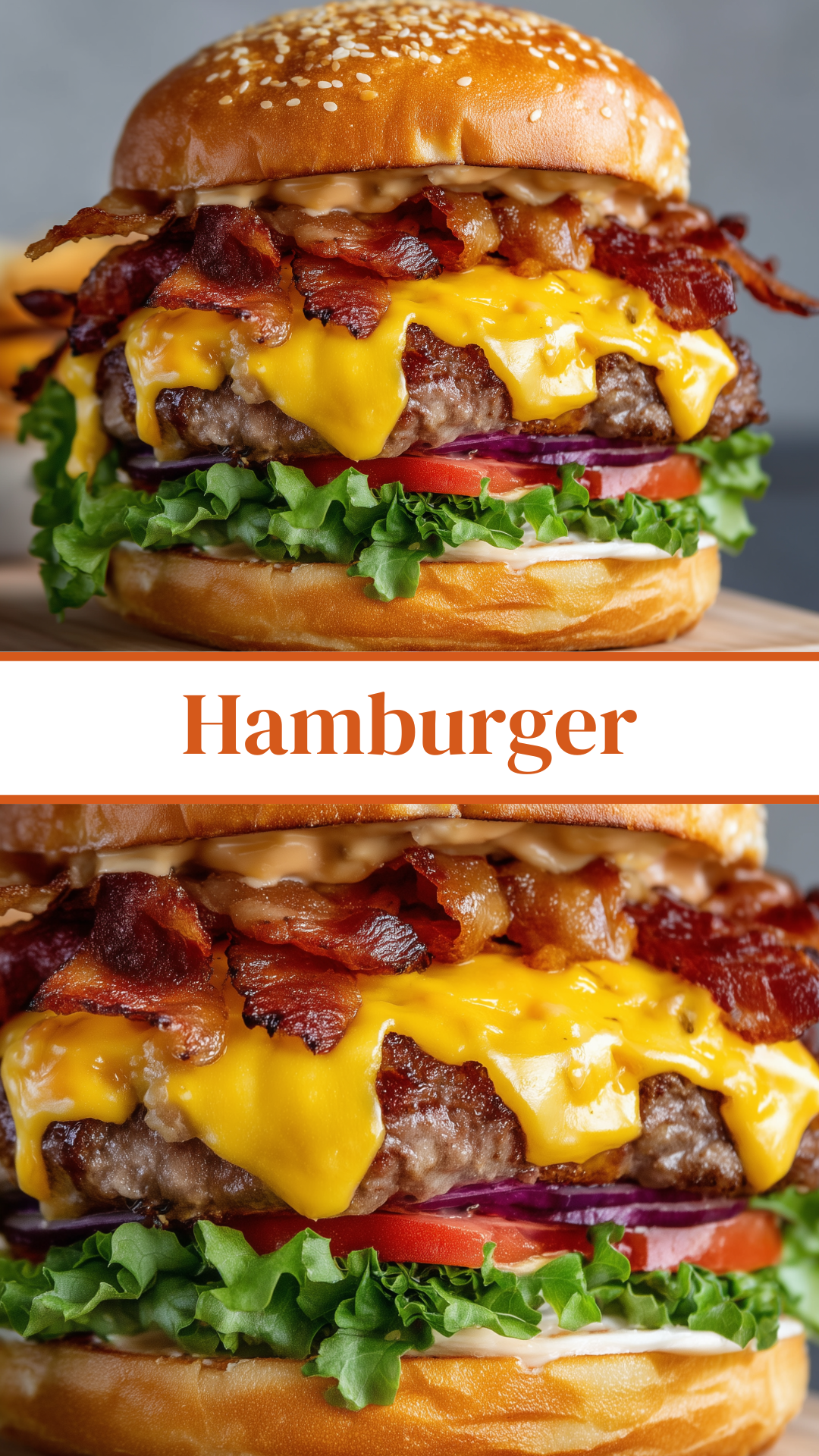The Classic Homemade Hamburger: Building Your Perfect Patty & Burger 🍔
The Hamburger isn’t just food; it’s a cultural phenomenon, a symbol of casual dining, barbecues, and pure culinary satisfaction. While countless variations exist in restaurants, creating the perfect burger at home allows for unparalleled control over quality, flavor, and juiciness. This recipe guides you through crafting a classic, savory beef patty that forms the heart of an unforgettable homemade hamburger, ready to be customized with your favorite toppings and condiments. Get ready to experience the ultimate comfort food, made exactly to your liking.
(History and Cultural Significance)
The origins of the hamburger are debated, but its evolution into the quintessential American dish is undeniable. While ground meat patties existed in various forms across Europe (like German Frikadellen or Russian bitki), the concept of serving a ground beef patty between two slices of bread (or a bun) gained traction in the late 19th and early 20th centuries in the United States. Its popularity exploded with the rise of fast-food chains in the mid-20th century, making it a ubiquitous, accessible, and highly customizable meal. Today, the hamburger transcends borders, celebrated in gourmet restaurants and backyard grills alike, continually reinventing itself while retaining its fundamental appeal.
(Key Ingredients 🥩🍞🧀🍅🧅🥬 & Detailed Preparation)
The secret to a great burger lies in starting with quality ingredients and handling them with care.
Ingredients (for 4 Hamburgers):
- For the Burger Patties:
- Ground Beef 🥩: 600g (about 1.3 lbs), ideally 80% lean / 20% fat (this fat content is crucial for juiciness and flavor)
- Fine Sea Salt 🧂: 1 tsp, or to taste
- Freshly Ground Black Pepper ⚫: ½ tsp, or to taste
- Garlic Powder 🧄: ½ tsp (optional, for subtle flavor)
- Onion Powder 🧅: ½ tsp (optional, for subtle flavor)
- For Assembly & Serving:
- Hamburger Buns 🍞: 4 (brioche, potato, or classic sesame buns work well)
- Cheese slices 🧀: 4 (Cheddar, American, Swiss, Provolone – optional)
- Lettuce leaves 🥬: 4-8 (romaine, iceberg, or green leaf)
- Tomato 🍅: 1-2, thinly sliced
- Red Onion 🧅: ½, thinly sliced or rings
- Pickles 🥒: Dill pickle slices, to taste
- Condiments: Ketchup, Mustard (Dijon, yellow), Mayonnaise, BBQ sauce, etc.
- Olive oil or vegetable oil 🫒: 1 tbsp (for cooking, if pan-frying)

Method of Preparation:
- Prepare the Burger Patties:
- Place the ground beef in a large mixing bowl.
- Sprinkle the salt, black pepper, garlic powder (if using), and onion powder (if using) over the meat.
- Gently mix the seasoning into the meat with your hands. Do not overmix or compact the meat, as this will result in a tough, dense patty. Mix just enough to distribute the seasoning.
- Divide the seasoned meat into 4 equal portions.
- Form each portion into a patty about 1-inch (2.5 cm) thick and slightly wider than your burger buns (they will shrink during cooking).
- Create a small indentation (about ½-inch / 1.2 cm deep) in the center of each patty with your thumb. This dimple helps prevent the burger from puffing up in the middle during cooking, ensuring even cooking and a flatter patty.
- Place the formed patties on a plate or tray lined with parchment paper. If not cooking immediately, cover and refrigerate for at least 15 minutes to allow them to firm up.
- Prepare Buns and Toppings:
- While the patties are cooking, slice the tomato and onion, wash and dry the lettuce.
- Toast the hamburger buns. This is crucial for texture and preventing sogginess. You can toast them cut-side down in a dry skillet, on a grill, or under the broiler for 1-2 minutes until lightly golden. Set aside.
- Cook the Burger Patties (Choose Your Method):
- Method A: Pan-Frying (Stovetop)
- Heat a large cast-iron skillet or heavy-bottomed frying pan over medium-high heat. Add 1 tablespoon of oil.
- Once the pan is hot and shimmering, place the patties in the skillet. Don’t overcrowd the pan (cook in batches if necessary).
- Cook for 3-5 minutes per side for medium-rare, or longer to your desired doneness. Do not press down on the patties with your spatula, as this squeezes out the juices.
- If adding cheese, place a slice on top of each patty during the last minute of cooking, covering the pan briefly to help it melt.
- Method B: Grilling (BBQ)
- Preheat your grill to medium-high heat. Lightly oil the grill grates.
- Place patties directly on the hot grill.
- Grill for 4-6 minutes per side for medium-rare, or until desired doneness.
- Add cheese during the last minute of grilling if desired.
- Method C: Broiling (Oven)
- Preheat your broiler. Line a baking sheet with foil and place a wire rack on top.
- Place patties on the wire rack.
- Broil for 4-6 minutes per side for medium-rare, or until desired doneness. Watch carefully as broilers vary greatly.
- Add cheese during the last minute of broiling.
- Method A: Pan-Frying (Stovetop)
- Rest the Patties (Crucial!):
- Once cooked, transfer the patties to a plate and let them rest for 5 minutes. This allows the juices to redistribute throughout the meat, resulting in a much juicier burger.
- Assemble Your Hamburgers:
- Spread your desired condiments on the top and/or bottom toasted bun halves.
- Place a cooked burger patty (with melted cheese, if using) on the bottom bun.
- Layer with lettuce, tomato slices, onion rings, and pickles.
- Place the top bun on. Serve immediately!
(Estimated Preparation & Cooking Time)
- Active Prep: 15 minutes
- Cook Time: 10-15 minutes (depending on method and desired doneness)
- Total Time: Approximately 25-30 minutes
(Tips for the Perfect Homemade Hamburger)
- Fat Content is Key: An 80/20 ground beef ratio is ideal. The fat renders during cooking, keeping the burger moist and flavorful. Leaner meat tends to dry out.
- Handle Gently: Overworking the ground meat compresses it, leading to a dense, tough patty. Mix just enough to incorporate seasonings.
- The Dimple: Don’t forget the thumbprint in the center! It’s a simple trick to prevent the patties from bulging and becoming football-shaped.
- Don’t Press the Patties: Resist the urge to press down on the patties with your spatula while cooking. This squeezes out all the delicious juices.
- Season Generously: Season the patties just before cooking. Salt draws out moisture, so avoid seasoning too far in advance.
- Toast the Buns: This step makes a huge difference in texture and prevents the bun from becoming soggy from the juices.
- Rest the Meat: Just like a steak, resting the burger patty allows the juices to redistribute, ensuring every bite is succulent.
- Clean Grill/Pan: A clean, hot cooking surface helps prevent sticking and promotes a good sear.

(Variations and Enhancements)
- Seasoning Blends: Experiment with smoked paprika, chili powder, Worcestershire sauce (mixed into the meat), or a dash of liquid smoke for different flavor profiles.
- Cheese: Beyond Cheddar, try blue cheese crumbles, smoked Gouda, pepper jack, or a classic Swiss.
- Stuffed Burgers: Form two thinner patties, place cheese or other fillings in the middle, and seal the edges before cooking.
- Onion Jam/Caramelized Onions: A sweet and savory alternative to raw onion.
- Avocado/Guacamole: Creamy and fresh.
- Fried Egg: For a decadent “breakfast burger.”
- Sautéed Mushrooms: Earthy and savory.
- Special Sauces: Beyond classic ketchup and mustard, try a homemade “special sauce” (mayo, ketchup, relish, pinch of sugar), aioli, or a chipotle mayo.
(Serving Suggestions)
A homemade hamburger is a meal in itself, but it pairs perfectly with classic sides:
- French Fries or Sweet Potato Fries
- Onion Rings
- Coleslaw
- Potato Salad
- Corn on the Cob
- A Simple Green Salad (to add a fresh counterpoint)
Beverage Pairing:
A cold soda, a classic American beer (lager or IPA), or even a robust red wine (like a Zinfandel or Cabernet Sauvignon) can complement a good burger.
(Aspect Visuel)
A perfectly assembled homemade hamburger is a sight to behold: a glistening, browned patty (often with melted cheese) peeking out from between a toasted, golden bun. Layers of crisp green lettuce, vibrant red tomato, and thinly sliced white or red onion add freshness and color. A slight drizzle of sauce and perhaps a few pickle slices complete the inviting picture of classic American comfort food.
(General Nutritional Information (per serving, highly variable))
The nutritional content will vary significantly based on the type and amount of ground beef, cheese, bun choice, and condiments used. However, for a typical homemade hamburger (patty + bun + cheese + basic toppings):
- Calories: 500-800+ kcal
- Protein: 30-45g (excellent source)
- Fats: 30-50g (from meat, cheese, bun, sauces)
- Carbohydrates: 30-50g (from bun, some toppings/sauces)
- Sodium: Can vary depending on seasoning and condiments.
While a treat, a homemade burger can be a satisfying and complete meal.

(Conclusion)
The Classic Homemade Hamburger is more than just a meal; it’s a testament to the joy of simple, well-prepared food. With just a few key ingredients and attention to detail, you can transform humble ground beef into a juicy, flavorful patty that serves as the foundation for endless customization. Whether you load it up with all the fixings or prefer a minimalist approach, the satisfaction of biting into a perfect homemade burger is unparalleled. It’s a truly timeless classic, delivering comfort and deliciousness every time.

